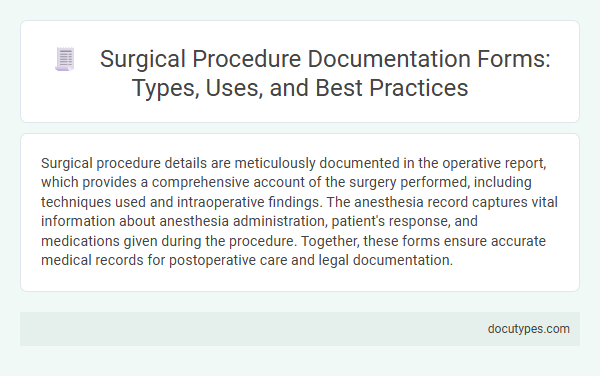Surgical procedure details are meticulously documented in the operative report, which provides a comprehensive account of the surgery performed, including techniques used and intraoperative findings. The anesthesia record captures vital information about anesthesia administration, patient's response, and medications given during the procedure. Together, these forms ensure accurate medical records for postoperative care and legal documentation.
Introduction to Surgical Procedure Documentation Forms
What forms record surgical procedure details? Surgical procedure documentation forms are essential for accurately capturing all aspects of a surgical intervention. These forms include operative reports, anesthesia records, and consent forms, which ensure clear communication among medical professionals and support patient safety.
Importance of Accurate Surgical Documentation
Surgical Procedure Reports are essential forms used to record detailed information about surgeries, including patient data, procedure steps, and outcomes. Accurate surgical documentation ensures clear communication among healthcare professionals, reduces medical errors, and supports legal and billing requirements. Your adherence to precise record-keeping enhances patient safety and improves overall medical care quality.
Common Types of Surgical Procedure Forms
Surgical procedure forms are essential documents that record detailed information about a patient's surgery. These forms ensure accurate documentation of the procedure, patient data, and surgical team involvement.
Common types of surgical procedure forms include the operative report, consent form, and anesthesia record. The operative report provides a comprehensive summary of the surgical intervention, while the consent form documents the patient's permission for surgery.
Preoperative Documentation Forms
Preoperative documentation forms are essential for recording detailed information about surgical procedures before they take place. These forms include patient history, consent, surgical site verification, and anesthesia assessment to ensure safety and accuracy. They facilitate clear communication among medical staff and help prevent errors during surgery.
Intraoperative Documentation Templates
Intraoperative documentation templates are essential forms that record detailed surgical procedures. These templates ensure accurate and standardized capture of operative events and patient information during surgery.
- Surgical Operative Report - A comprehensive form documenting the procedure performed, operative findings, and surgical techniques used.
- Anesthesia Record - Captures anesthesia details, including drugs administered, patient monitoring, and vital signs throughout the operation.
- Intraoperative Nursing Record - Tracks nursing activities, instrument counts, and any intraoperative complications during the surgical procedure.
Postoperative Surgical Documentation Sheets
| Form Type | Description | Key Details Recorded |
|---|---|---|
| Postoperative Surgical Documentation Sheets | These forms document important details immediately following a surgical procedure, capturing information essential for patient care and medical records. |
|
Postoperative surgical documentation sheets ensure your surgical team records comprehensive information vital for continued patient management and clinical audits.
Electronic vs. Paper-based Surgical Forms
Recording surgical procedure details is essential for patient care continuity and legal documentation. Surgical forms can be either electronic or paper-based, each with distinct advantages for accuracy and accessibility.
- Electronic Surgical Forms - These forms allow for real-time data entry, easy retrieval, and integration with other digital health records.
- Paper-based Surgical Forms - Traditional paper forms provide a tangible record and can be used in environments lacking digital infrastructure.
- Accuracy and Efficiency - Electronic forms reduce errors and improve efficiency, while paper forms may require more manual handling and risk of loss.
Regulatory and Legal Considerations
Surgical procedure details are recorded using standardized operative reports and surgical consent forms. These documents capture critical information such as the type of surgery, techniques used, anesthesia details, and any intraoperative findings.
Regulatory bodies mandate precise documentation to ensure patient safety and compliance with healthcare laws. Your surgical records must adhere to legal standards set by entities like The Joint Commission and HIPAA regulations to protect patient privacy and facilitate audits.
Best Practices for Completing Surgical Documentation Forms
Accurate documentation of surgical procedures is essential for patient safety, legal compliance, and effective communication among healthcare providers. Specific forms are designed to capture detailed information about each surgical intervention to ensure comprehensive records.
- Surgical Operative Report - This form provides a detailed account of the procedure performed, including the surgical technique, findings, and any complications encountered.
- Anesthesia Record - Documents the types and dosages of anesthesia administered, vital signs, and patient response throughout the surgery.
- Consent for Surgery Form - Records the patient's informed consent, outlining the risks, benefits, and alternatives of the planned procedure.
Best practices for completing these forms include documenting promptly after surgery, using clear and precise language, and ensuring all relevant details are accurately recorded.
What Forms Record Surgical Procedures Details? Infographic

